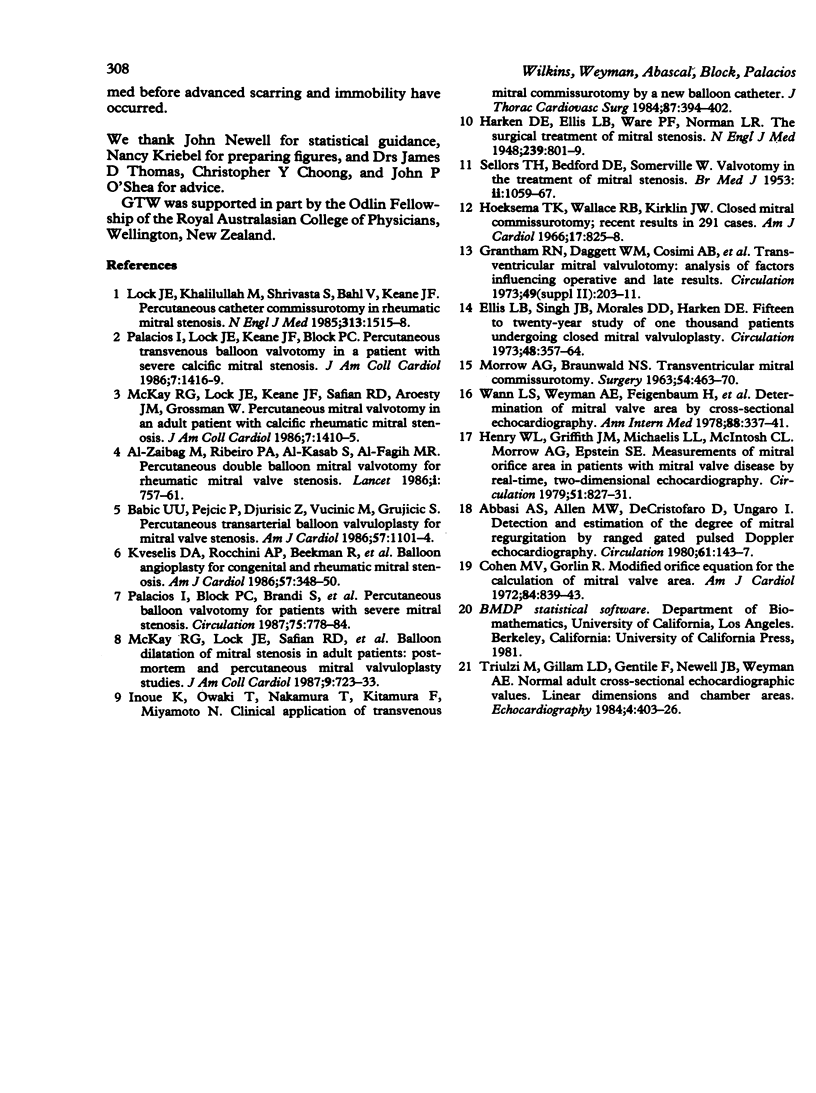Abstract
Twenty two patients (four men, 18 women, mean age 56 years, range 21 to 88 years) with a history of rheumatic mitral stenosis were studied by cross sectional echocardiography before and after balloon dilatation of the mitral valve. The appearance of the mitral valve on the pre-dilatation echocardiogram was scored for leaflet mobility, leaflet thickening, subvalvar thickening, and calcification. Mitral valve area, left atrial volume, transmitral pressure difference, pulmonary artery pressure, cardiac output, cardiac rhythm, New York Heart Association functional class, age, and sex were also studied. Because there was some increase in valve area in almost all patients the results were classified as optimal or suboptimal (final valve area less than 1.0 cm2, final left atrial pressure greater than 10 mm Hg, or final valve area less than 25% greater than the initial area). The best multiple logistic regression fit was found with the total echocardiographic score alone. A high score (advanced leaflet deformity) was associated with a suboptimal outcome while a low score (a mobile valve with limited thickening) was associated with an optimal outcome. No other haemodynamic or clinical variables emerged as predictors of outcome in this analysis. Examination of pre-dilatation and post-dilatation echocardiograms showed that balloon dilatation reliably resulted in cleavage of the commissural plane and thus an increase in valve area.
Full text
PDF









Images in this article
Selected References
These references are in PubMed. This may not be the complete list of references from this article.
- Abbasi A. S., Allen M. W., DeCristofaro D., Ungar I. Detection and estimation of the degree of mitral regurgitation by range-gated pulsed doppler echocardiography. Circulation. 1980 Jan;61(1):143–147. doi: 10.1161/01.cir.61.1.143. [DOI] [PubMed] [Google Scholar]
- Al Zaibag M., Ribeiro P. A., Al Kasab S., Al Fagih M. R. Percutaneous double-balloon mitral valvotomy for rheumatic mitral-valve stenosis. Lancet. 1986 Apr 5;1(8484):757–761. doi: 10.1016/s0140-6736(86)91780-0. [DOI] [PubMed] [Google Scholar]
- Babic U. U., Pejcic P., Djurisic Z., Vucinic M., Grujicic S. M. Percutaneous transarterial balloon valvuloplasty for mitral valve stenosis. Am J Cardiol. 1986 May 1;57(13):1101–1104. doi: 10.1016/0002-9149(86)90682-x. [DOI] [PubMed] [Google Scholar]
- Cohen M. V., Gorlin R. Modified orifice equation for the calculation of mitral valve area. Am Heart J. 1972 Dec;84(6):839–840. doi: 10.1016/0002-8703(72)90080-4. [DOI] [PubMed] [Google Scholar]
- Ellis L. B., Singh J. B., Morales D. D., Harken D. E. Fifteen-to twenty-year study of one thousand patients undergoing closed mitral valvuloplasty. Circulation. 1973 Aug;48(2):357–364. doi: 10.1161/01.cir.48.2.357. [DOI] [PubMed] [Google Scholar]
- Henry W. L., Griffith J. M., Michaelis L. L., McIntosh C. L., Morrow A. G., Epstein S. E. Measurement of mitral orifice area in patients with mitral valve disease by real-time, two-dimensional echocardiography. Circulation. 1975 May;51(5):827–831. doi: 10.1161/01.cir.51.5.827. [DOI] [PubMed] [Google Scholar]
- Inoue K., Owaki T., Nakamura T., Kitamura F., Miyamoto N. Clinical application of transvenous mitral commissurotomy by a new balloon catheter. J Thorac Cardiovasc Surg. 1984 Mar;87(3):394–402. [PubMed] [Google Scholar]
- Kveselis D. A., Rocchini A. P., Beekman R., Snider A. R., Crowley D., Dick M., Rosenthal A. Balloon angioplasty for congenital and rheumatic mitral stenosis. Am J Cardiol. 1986 Feb 1;57(4):348–350. doi: 10.1016/0002-9149(86)90922-7. [DOI] [PubMed] [Google Scholar]
- Lock J. E., Khalilullah M., Shrivastava S., Bahl V., Keane J. F. Percutaneous catheter commissurotomy in rheumatic mitral stenosis. N Engl J Med. 1985 Dec 12;313(24):1515–1518. doi: 10.1056/NEJM198512123132405. [DOI] [PubMed] [Google Scholar]
- MORROW A. G., DUPLESSIS L. A., WILCOX B. R. HEMODYNAMIC STUDIES AFTER MITRAL COMMISSUROTOMY. Surgery. 1963 Sep;54:463–470. [PubMed] [Google Scholar]
- McKay R. G., Lock J. E., Keane J. F., Safian R. D., Aroesty J. M., Grossman W. Percutaneous mitral valvuloplasty in an adult patient with calcific rheumatic mitral stenosis. J Am Coll Cardiol. 1986 Jun;7(6):1410–1415. doi: 10.1016/s0735-1097(86)80164-4. [DOI] [PubMed] [Google Scholar]
- McKay R. G., Lock J. E., Safian R. D., Come P. C., Diver D. J., Baim D. S., Berman A. D., Warren S. E., Mandell V. E., Royal H. D. Balloon dilation of mitral stenosis in adult patients: postmortem and percutaneous mitral valvuloplasty studies. J Am Coll Cardiol. 1987 Apr;9(4):723–731. doi: 10.1016/s0735-1097(87)80224-3. [DOI] [PubMed] [Google Scholar]
- Palacios I. F., Lock J. E., Keane J. F., Block P. C. Percutaneous transvenous balloon valvotomy in a patient with severe calcific mitral stenosis. J Am Coll Cardiol. 1986 Jun;7(6):1416–1419. doi: 10.1016/s0735-1097(86)80165-6. [DOI] [PubMed] [Google Scholar]
- Palacios I., Block P. C., Brandi S., Blanco P., Casal H., Pulido J. I., Munoz S., D'Empaire G., Ortega M. A., Jacobs M. Percutaneous balloon valvotomy for patients with severe mitral stenosis. Circulation. 1987 Apr;75(4):778–784. doi: 10.1161/01.cir.75.4.778. [DOI] [PubMed] [Google Scholar]
- SELLORS T. H., BEDFORD D. E., SOMERVILLE W. Valvotomy in the treatment of mitral stenosis. Br Med J. 1953 Nov 14;2(4845):1059–1067. doi: 10.1136/bmj.2.4845.1059. [DOI] [PMC free article] [PubMed] [Google Scholar]
- Wann L. S., Weyman A. E., Feigenbaum H., Dillon J. C., Johnston K. W., Eggleton R. C. Determination of mitral valve area by cross-sectional echocardiography. Ann Intern Med. 1978 Mar;88(3):337–341. doi: 10.7326/0003-4819-88-3-337. [DOI] [PubMed] [Google Scholar]







